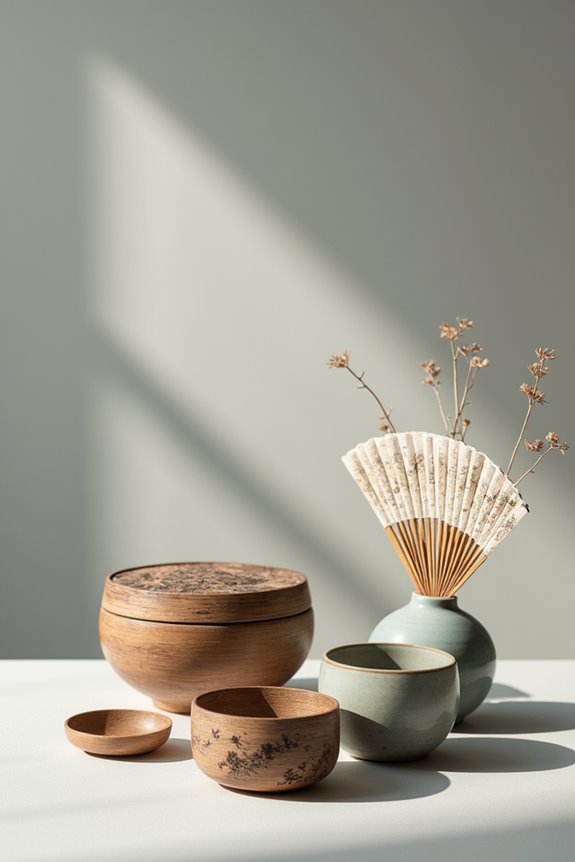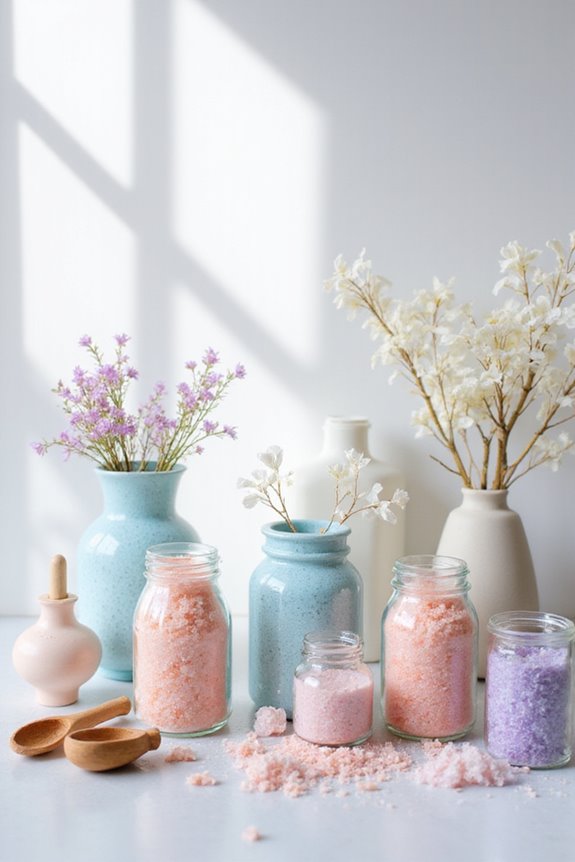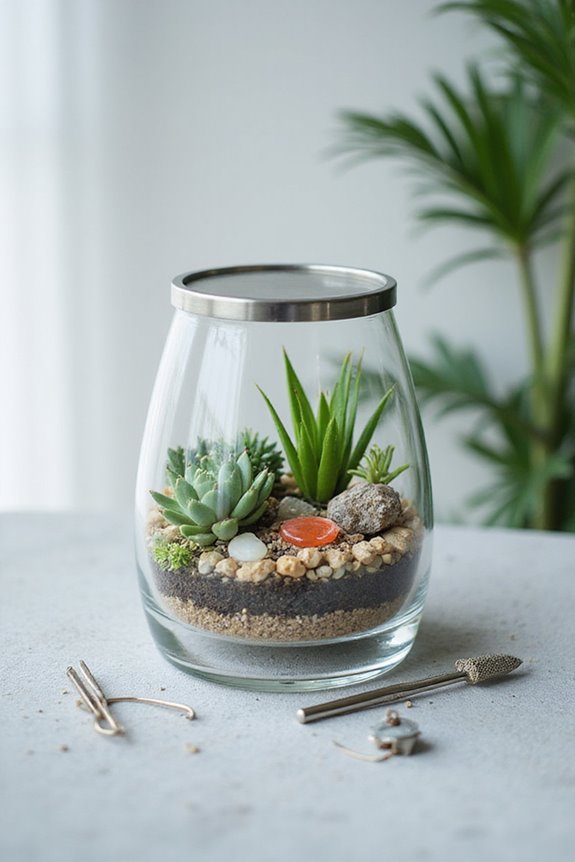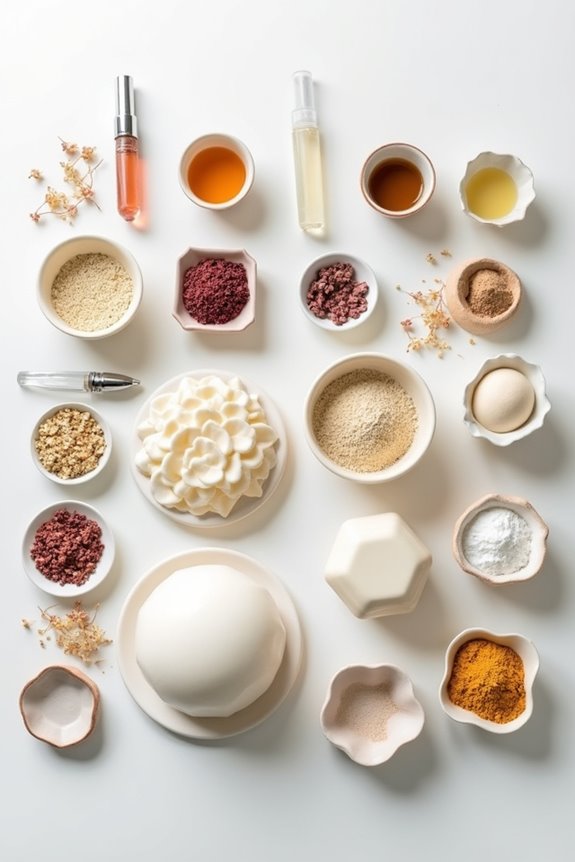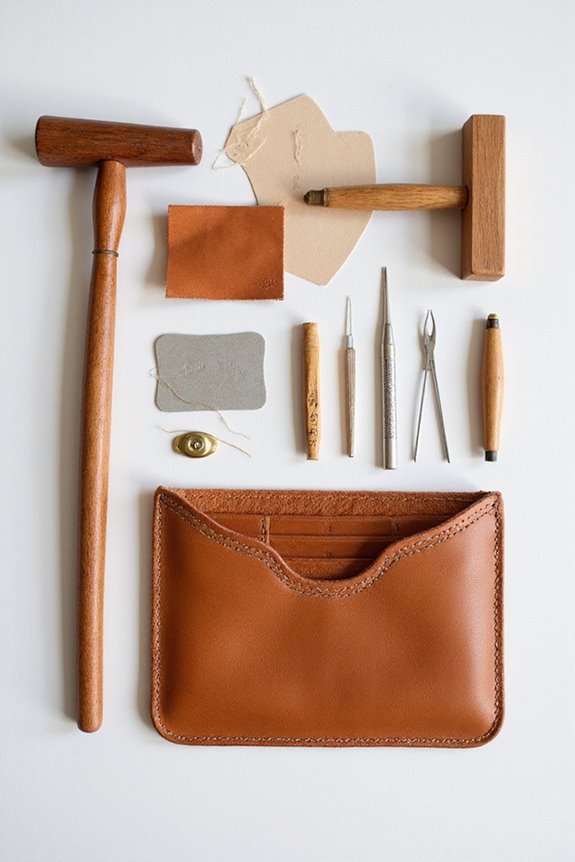Korean traditional crafts encompass a diverse range of artistic practices, with significant roots in history. Pottery, particularly Goryeo celadon and Joseon porcelain, showcases unique techniques like *sanggam*, where colored clays fill carved designs. We also have a long-standing papermaking tradition using Hanji, derived from the Paper Mulberry tree, known for its durability. Metalworking evolved during the Bronze Age, producing intricate decorative and functional items. Each craft reflects Korea’s rich cultural heritage, offering much to explore further.
Key Takeaways
- Korean traditional crafts include pottery, ceramics, papermaking, metalwork, and textile arts, showcasing cultural heritage and artistic expression.
- Pottery features unique styles like Goryeo celadon and Joseon white porcelain, highlighting advanced techniques and natural materials.
- Hanji paper, made from Paper Mulberry bark, is known for its durability and intricate crafting methods, serving multiple artistic purposes.
- Metalwork, evolving since the Bronze Age, highlights casting and inlay techniques, producing both functional tools and decorative items.
- Contemporary efforts focus on preserving these crafts through education, artisan collaboration, and modern adaptations to keep them relevant today.
Historical Origins of Korean Crafts
Korean crafts have roots that date back to prehistoric times, illustrating a rich tapestry of cultural evolution that we can appreciate today. Early inhabitants, who migrated from Siberia via Manchuria, introduced distinctive styles seen in ancient artifacts. For instance, Stone Age votive sculptures and petroglyphs create a narrative of creativity dating back to around 3000 BC. Additionally, Neolithic pottery emerged around 7,000 BC, showcasing flat-bottomed wares made with clay that had been fired at low temperatures. These examples also exhibit relief decorations and geometric patterns reminiscent of Siberian influences, reflecting the interplay of prehistoric influences in the development of Korean craft methods. Together, these elements signify the foundational aspects of Korean cultural evolution that continue to resonate in contemporary practices.
Pottery and Ceramics: A Timeless Art
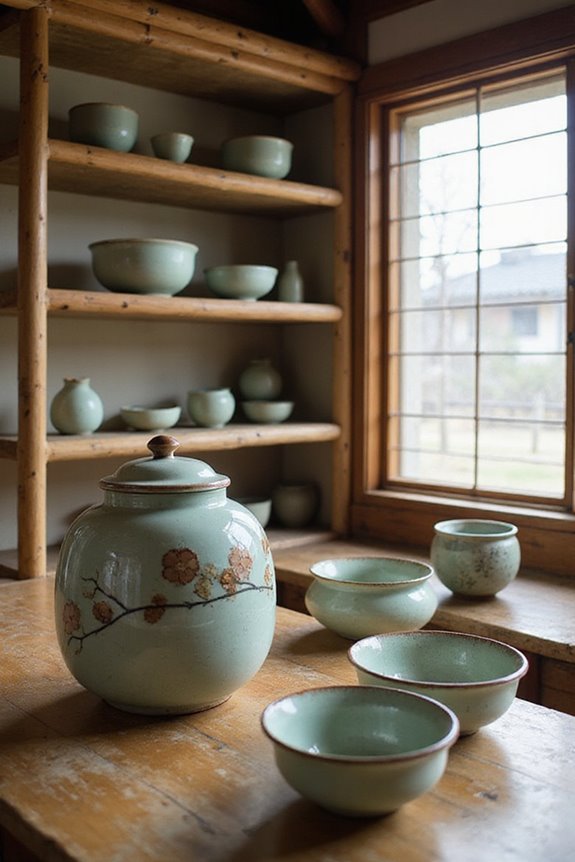
Throughout history, pottery and ceramics have played an essential role in many cultures, and the significance of these art forms cannot be overstated. In Korea, traditional techniques like throwing and coiling were perfected over millennia, producing distinctive styles such as Goryeo celadon and Joseon white porcelain. The aesthetic evolution of these ceramics reflects both cultural influences and innovations, highlighted by the unique inlay technique known as *sanggam*, where carved designs are filled with colored clays. Using natural materials like local clays and wood ash glazes, artisans create textures and colors that convey beauty and meaning. Additionally, symbolic motifs, including lotus flowers and cranes, connect these works to Korea’s rich cultural heritage, showcasing the timeless artistry in each piece.
The Craft of Papermaking and Printing
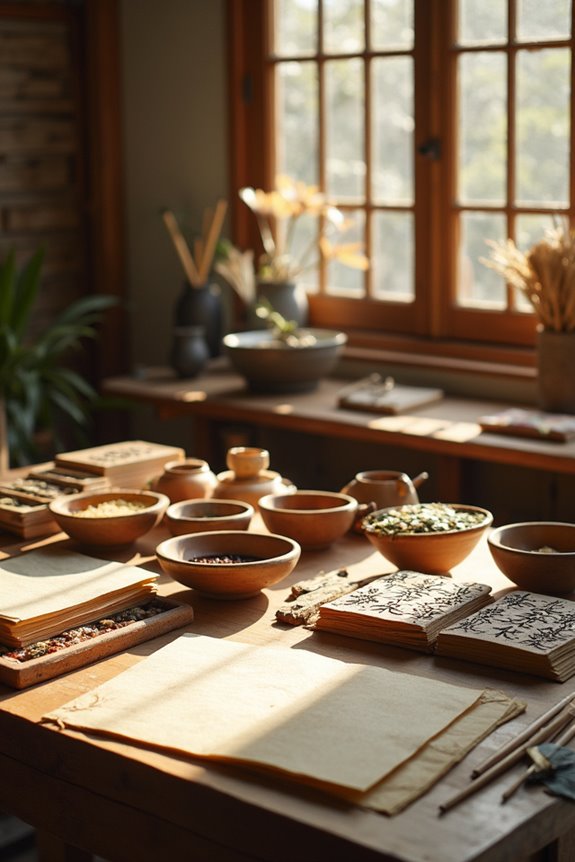
Building on the significance of pottery and ceramics in Korean culture, we find that the craft of papermaking has also played an essential role in shaping the nation’s artistic and historical narratives. With a rich papermaking history spanning over 1,300 years, traditional materials like the bark of the Paper Mulberry tree have been foundational in creating Hanji. This unique paper, noted for its durability, has intricate Hanji techniques, including laminated sheet-making methods, which enhance its strength and versatility. Artistic applications of Hanji extend beyond writing to crafts and traditional printing, as its ability to hold ink without bleeding makes it preferred among artists. Today, we witness modern revivals, ensuring that this valued heritage continues to flourish in contemporary art and culture.
Metalcraft and Tool-Making Techniques
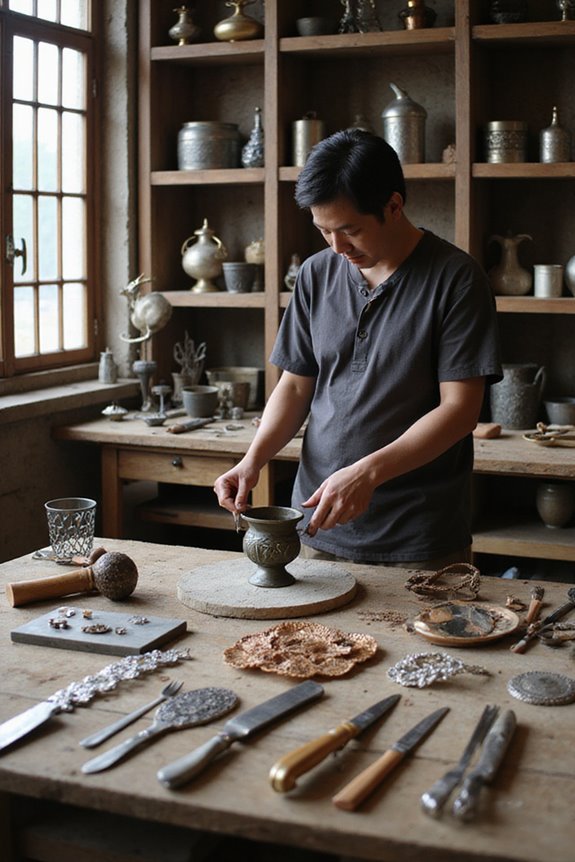
While exploring the rich heritage of metalcraft, we recognize its historical significance and lasting influence on Korean society. Metalworking techniques have evolved since the Bronze Age, resulting in an array of artistic practices. During the Three Kingdoms Period, distinct styles emerged that featured complex motifs, like floral and animal designs, seen in hinges and ceremonial pieces. Techniques such as casting and inlay were essential for producing functional and decorative items. Inlay often employed gold and silver, embedding them into detailed grooves, while chasing and repoussé highlighted relief patterns. Tools produced from iron and bronze showcased advancements in metallurgy, emphasizing durability for practical applications. Collectively, these techniques and artistic motifs have shaped Korea’s cultural identity and continue to hold relevance today.
Textile and Decorative Arts in Korea
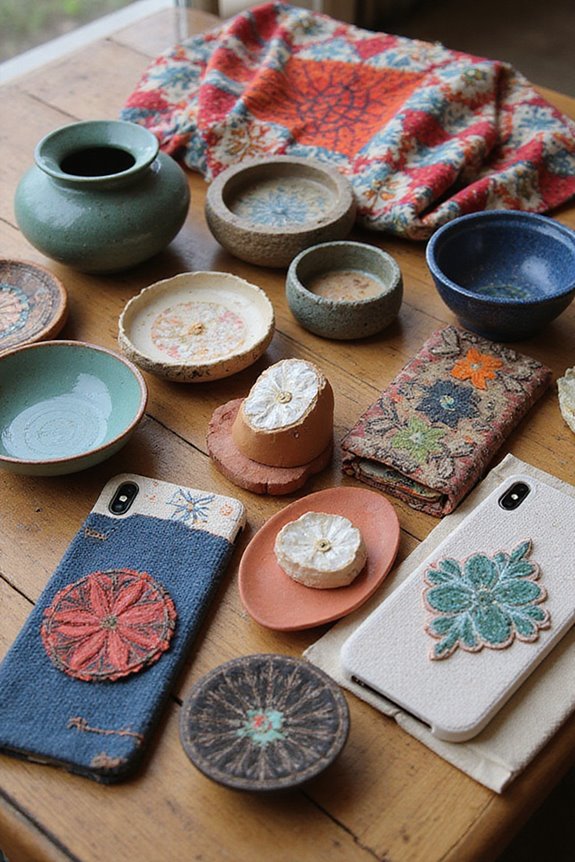
Textile and decorative arts in Korea reflect a rich tapestry of cultural heritage that merges practical utility with artistic expression. One prominent example is the Bojagi techniques, traditional wrapping cloths made from various fabrics like silk and cotton. Historically, these cloths served practical purposes, such as wrapping and storing items, showcasing both vibrant colors and patchwork designs. The symbolism woven into these textiles often represents good fortune and protection, deeply rooted in Korean culture. Artisans utilize meticulous hand stitching to create visually appealing pieces that embody both aesthetic and functional qualities. From royal court textiles to everyday applications, the diverse techniques highlight a dynamic interplay between heritage and contemporary artistry, ensuring these crafts remain relevant today.
Cultural Significance of Traditional Crafts
Traditional crafts hold immense cultural significance in Korea, revealing layers of social identity and historical context. These crafts serve as reflections of our historical eras, showcasing techniques that embody the artistic and social values of their time. For instance, traditional items like bojagi, used for wrapping, symbolize good fortune and protection, while mother-of-pearl lacquerware features motifs representing nobility, such as chrysanthemums. Each craft technique contributes to preserving our cultural identity, as they often convey symbolic meanings related to luck or spiritual beliefs. Additionally, these artisans pass down their skills through generations, fostering continuity in our cultural heritage. As we engage with these crafts, we strengthen our connection to Korean narratives, enhancing our understanding of collective identity.
Social Context and Class Influence on Craftsmanship
In examining the social context and class influence on craftsmanship in Korea, we find that craftsmen historically occupied a complex position within the social hierarchy. Traditionally, artisans held a low status, ranking below scholars and farmers but above merchants. Their skills were essential for military, city construction, and various artistic pursuits, even as some roles, like butchers and leather-workers, were viewed negatively due to cultural beliefs. During the Joseon period, most artisan roles were hereditary and required government licenses, reflecting a rigid craft hierarchy. Additionally, the materials available often depended on social standing, with elite patrons influencing the production and techniques, such as the use of blue cobalt in ceramics, reinforcing the distinction between classes in craftsmanship.
Contemporary Preservation of Craft Traditions
Craftsmanship in Korea is experiencing a notable revival through various contemporary preservation efforts that aim to safeguard these valued traditions. Government initiatives recognize master craftspeople as holders of intangible cultural assets, ensuring craft sustainability by supporting apprenticeships and skill transfer. Institutions like the National Intangible Heritage Centre facilitate artisan collaboration, creating opportunities for workshops and exhibitions that promote Korean crafts. Furthermore, adaptations of traditional crafts, such as Hanji paper, into modern designs make them relevant in today’s market. Educational programs in schools and community centers teach traditional techniques, fostering new generations of artisans. These all-encompassing efforts not only preserve heritage but also revitalize economies by linking traditional craftsmanship to daily life, ensuring a sustainable future for these crafts.
Frequently Asked Questions
What Materials Are Commonly Used in Traditional Korean Crafts?
In our exploration of traditional Korean crafts, we discover natural materials like mulberry bark and hemp, alongside intricate crafting techniques such as weaving and inlaying. Together, they create beautiful, culturally significant works of art.
How Are Traditional Crafts Taught and Passed Down in Korea?
In Korea, we learn traditional crafts through hands-on apprenticeships and structured courses emphasizing craftsmanship techniques, ensuring our cultural heritage thrives. This immersive training nurtures creativity while preserving techniques passed down by master artisans.
What Are Some Modern Adaptations of Korean Traditional Crafts?
We see modern adaptations of Korean traditional crafts through cultural fusion, where artisans use modern techniques to redesign items like hanbok and celadon, making them relevant and appealing to today’s audiences while preserving our rich heritage.
Are There Any Notable Festivals Celebrating Korean Traditional Crafts?
Yes, there’re several craft festivals that celebrate Korean cultural heritage. These vibrant cultural celebrations connect us with artisans and traditional techniques, showcasing everything from hanji making to intricate maedeup knotting. Let’s explore and appreciate together!
How Do Traditional Crafts Influence Contemporary Korean Art and Design?
Ah, isn’t it amusing how traditional crafts shape contemporary art and design? They’re not just relics; they’re our cultural identity, sparking design innovation and transforming perception globally, connecting past and future in ways we never imagined.

